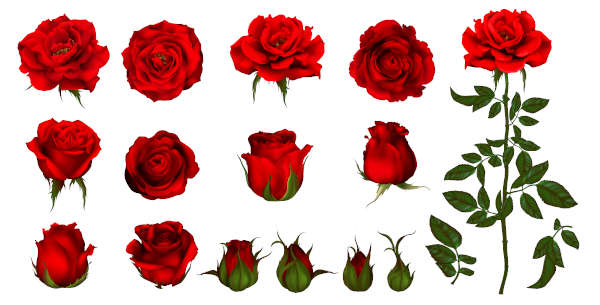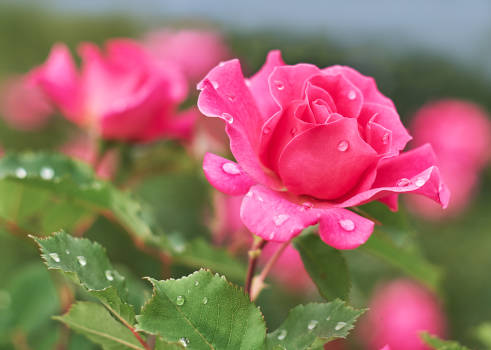The relationship between humans and roses (Rosa species) goes back over 5,000 years. In that time, roses have been the subject of folklore, poetry, legend, and medical science alike.
There are over 150 different types of domestic roses, with thousands of named varieties between them. Some are big, showy double blooms, others are smaller single blooms valued for their nutritious fruit — the rose hip.
Some are strongly fragrant, while others have no scent to speak of. All roses are powerful magical and medicinal allies.
Magical Properties of Rose
According to some sources, roses can be substituted for any flower called for in a spell. While this isn’t strictly true, it’s a known fact that roses are among the most versatile magical ingredients. They might be best known as a love herb, but that’s far from their only use.
Speaking of love herbs, roses encompass all forms of love. The color of the rose, as well as what other herbs it’s blended with, determine the kind of love. Yellow is generally used for friendships, pink for light romantic or self love, and red for passion.
Since many varieties have noticeable thorns, roses are also often used for protection. Washing clothes with rosewater makes them magically protective.
Rose thorns can also be used to mark candles or wax figures, similarly to nails.
Roses are ruled by the planet Venus and the element of water. They are associated with the zodiac sign Taurus.
Benefits & Uses of Rose
Rose hips, the fruit of the rose, are high in vitamin C. They are often included in tea, or may be made into jelly or preserves. Oil pressed from rose hip seeds is a popular anti-aging ingredient in cosmetics.
Rosewater is a gentle astringent often used as a toner for sensitive or aging skin.
Rose essential oil is said to reduce stress, enhance libido, improve mood, and boost circulation.

The petals of the rose have antiseptic, antiparasitic, and anti-inflammatory properties, as well as a mild laxative effect. Roses are also said to help reduce fevers.
Research published in the Scandinavian Journal of Rheumatology found that a rose hip supplement helped to reduce the symptoms of both osteoarthritis and rheumatoid arthritis better than a placebo.
Another study found that rose hips helped to lower systolic blood pressure and cholesterol levels for heart patients, but increased vascular inflammation markers.
Possible Risks & Side Effects of Rose
Some people are allergic to roses. Allergies can range from mild to life-threatening, and may appear as anything from mild rashes or itching, to stomach upset, to anaphylaxis. If you are allergic to any member of the rose family, please use another herb in its place.
Natural rose oil is fairly expensive. For this reason, many rose-scented products rely on synthetic equivalents which don’t have medicinal value. Always read ingredient lists before using any botanical preparation.
Rose hips may cause some side effects, like restless sleep, nausea, heartburn, diarrhea, and fatigue. It can also interact with certain medications, chiefly because it contains a lot of vitamin C.
There aren’t enough studies to determine if roses or rose hips are safe for those who are pregnant or breast feeding. While they are likely safe in the amounts you’d use to flavor food or tea, no research has been conducted to determine if they’re safe in supplement form. Talk to your doctor to see if it’s okay for you to use rose or rose hips internally.
Rose History & Folklore
There are so many stories and legends involving roses, it would be next to impossible to recount them all here.
In the Illiad, Hector’s body is said to have been anointed with rose oil after his death.
In Scandinavian folklore, Prince Lindworm was born when a childless queen went to an old crone for help. The crone advised her to eat the a magical red rose if she wanted to conceive a son, and a white one for a daughter, but to never eat both.
The Queen, blinded by desperation, consumes both and gives birth to both a healthy son, and a terrifying, wingless serpent.
Roses were first domesticated in China. It wasn’t long before they became important ornamental, culinary, and medicinal plants elsewhere. Roman nobility had large public rose gardens, and the flowers were used as perfume, medicine, and confetti.

These flowers were also important in English heraldry. The War of the Roses was a series of devastating conflicts for English succession between the Houses of Lancaster and York, both cadet branches of the House of Plantagenet.
Lancaster was represented by a red rose, and York by a white one. King Henry VII united both houses, and used the heraldic Tudor rose, with five inner white petals to represent York, and five outer red ones to represent Lancaster.
The Rosicrucians also use roses in their symbolism.
In both English and German, there’s a loan phrase from Latin which translates to “under the rose.” This denotes secrecy. In Greek and Roman mythology, Cupid gave a rose to Harpocrates, the God of Silence, so he would keep Venus’ secrets.
Banquet halls had carved rose motifs in their rafters, symbolizing that all discussions that took place under them should be kept secret — just as Harpocrates kept the secrets of Venus.
Getting Started With Rose
Roses are very easy to come by, though not all roses will be suitable for magical or culinary purposes.
Most cut flowers are treated with herbicides, pesticides, and fungicides, which may be undesirable for those looking to make tea or infuse anointing oils. Instead, you may wish to try growing your own.
Fortunately for the green witches out there, many rose varieties are pretty easy to grow. They enjoy full sun and well-drained soil. Keep them moist until they’re established — for most people, that means watering once daily for two weeks.
After that, growing roses is largely a matter of making sure they’re watered twice a week, managing pests, and pruning them each spring.
If you don’t have a yard, or your yard is shady, you can still grow roses. Miniature varieties make excellent potted plants that will thrive indoors with a good grow light.
With enough rose petals, you can make your own rose water for use in protective or love magic, or as an offering to faeries, nature spirits, or love deities.
Remove petals from the flowers until you have about a full cup of fresh petals. Rinse them well to remove any dirt, bugs, or small stones. Place them in a sauce pot, and add just enough water to cover them completely.
Too much water will dilute the final product, while too little will allow the roses to burn. Simmer the mixture on low heat until the rose petals have lost their color — they’ll turn a beige or pale pink.
When this happens, turn off the heat and pour the mixture through a strainer to remove the petals. You’ll be left with nothing but pure, powerful rosewater.
Place it in a clean bottle, and store it someplace safe. Refrigerated, it will keep for up to a month. Unrefrigerated, its shelf life is about a week.
For an added magical punch, you can use distilled water charged under the light of a full moon to make your rosewater.
You may also wish to stir it with a spoon held in your dominant hand, visualize energy flowing into the water and rose petals, and say a chant or a few words to thank the roses and ask for their help.
Roses are a distinctive symbol of beauty and romance. There’s no mistaking their fragrance, flavor, or magical energy. If you haven’t quite delved into the world of flower magic, roses are an excellent first flower to work with.
